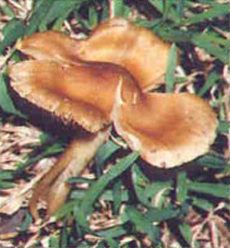
INOCYBE CORYDALINA
Inocybe corydalina is a rare and very weakly active magic mushroom. It is widely distributed in temperate forests of Europe and North America where it spreads through its symbiotic relation with plants.
It inherits its common name “green-flush fiber-cap” because of the tendency of its bruised flesh to turn greenish. Another member of the Inocybe family that presents a fibrous cap is Inocybe aeruginascens, the unique “feel good” strain that seems to have a very special entourage effect. Other mild strains growing naturally are Conocybe smithii and C. siennaphylla.
Inocybe corydalina, has two known varieties: Inocybe corydalina var. corydalina and Inocybe var. erinaceamorpha. Researches argue that both of the corydalina varieties are psilocybin-producing, Inocybe corydalina var. erinaceamorpha having tested positive to containing the poisonous compound muscarine.
Unfortunately, the result was not confirmed by other researches and the limited collection of specimen limits production of new data. Other chemical analyses show a rather weak concentration of psilocybin, often no psilocin and a fairly high level of baeocystin.
Most Inocybes have not been tested for neither their edibility, psilocybin activity or toxicity. Of those tested, none have been proven to contain both psilocybin and muscarine (the toxic substance). Psilocybe authority Stamet wonders if that cohabitation of compounds within one specie is possible and if it will eventually be brought to light.
This is yet another good example of the risky minefield of the Inocybe genus with over 1400 species of edible, psychoactive and poisonous mushrooms mixed, identification is tricky, and mistakes can be deadly.
Visual Description
INOCYBE CORYDALINA Potency
Habitat Origin



